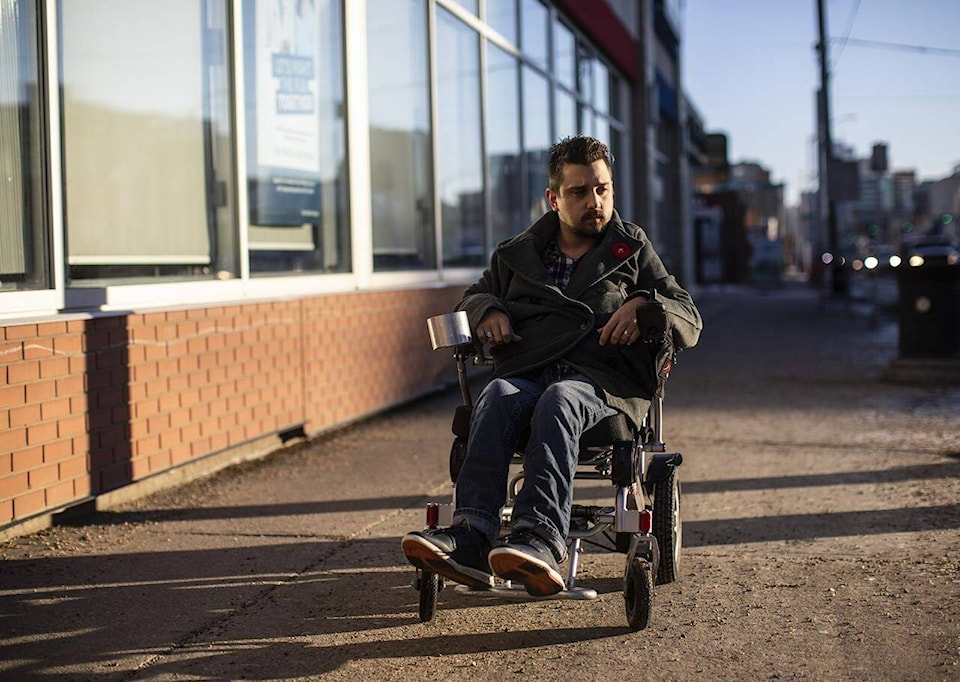EDMONTON — Brad Bartko says he looks up about 30 bars on the internet before he finds one that just might work for date night with his wife.
“I’m not even exaggerating,” says the 28-year-old Edmontonian who has cerebral palsy and has been using a wheelchair his whole life.
“You have to make sure someone in a wheelchair can get up to the establishment.”
Bartko says he can’t even get through the doorway at some bars and restaurants.
“Some places I can’t go to the bathroom. I can’t sit at a table with my friends. The (bar) has to (create a) makeshift table for me from the storage closet, but I’m separated from my group.”
Bartko says Edmonton establishments are not nearly as accessible as they could be.
“We need to level it up … because the only difference between me and able-bodied people is I’ve got four wheels strapped to my butt.”
That’s why Bartko, sitting in his building lobby that has a ramp connecting it to the outside, is on a mission.
He has started a consulting business called Disability Accessible by Design. Three bars have already hired him to educate staff on how to serve people with a disability and make the bar’s space more welcoming.
“People don’t understand that, as they age, they might end up in a wheelchair one day or a walker,” he says.
“People don’t realize this until it’s too late. That’s why these changes can benefit everyone.”
He’s to begin his work with a bar called 1st RND in Edmonton’s downtown in January.
“The changes that need to be made … they’re not hard to do.” he says.
They include lower tables, wider doors and bathrooms on the main floor. He also recommends changes in how wait staff serve customers.
“Some waiters get down on one knee to talk to me. (Others have) dumbed down their talk like talking to me like a baby.
“I’m 28! Don’t talk to me like that … You can still talk to me normally.”
Bartko says another common mistake servers make is asking the person he’s with what Bartko wants to order.
Franco Camminatore is the general manager of 1st RND. He says inviting Bartko to his bar was an easy and obvious decision.
“A lot of people don’t realize that physical disability doesn’t mean they have a mental one as well,” Camminatore said.
“I definitely recommend that (bars) at least do the best they can.”
The perk for businesses is that they are able to tap into a new customer base, he adds.
“We definitely get known just through word of mouth that we are accessible to everyone, so people come.”
Bartko says Toronto is one of the most accessible Canadian cities he has travelled through. Vancouver, Calgary and Montreal are also up there. But a lot of work still needs to be done in the country, he says.
“Edmonton is the worst,” he says.
“We can walk outside right now, by my front door, and there’s a chunk of sidewalk almost missing. For me to go over it … it’s a very bumpy ride.
“These are things that we need to fix, because, let’s be honest, it’s the 21st century.”
A 2019 survey of Canadians aged 15 and over with disabilities found an estimated one in five had at least one disability that limited activities of daily living.
The Canadian Standards Association describes accessibility on its website as “the design and construction of environments, services, and products that individuals experiencing disability can engage with without experiencing barriers, enabling full participation in society.”
The website also says Ontario was one of the first jurisdictions in the world to enact legislation in 2005 that set specific enforceable goals for accessibility. Manitoba followed in 2013 and Nova Scotia in 2017.
This report by The Canadian Press was first published Monday, Dec. 13, 2021.
___
This story was produced with the financial assistance of the Facebook and Canadian Press News Fellowship.
Fakiha Baig, The Canadian Press
